The biggest reason you fail at game jams (it's not your idea)
Listen to the devlog here (it’s not AI):
I was able to accomplish 21 days of work in just 10(!) with the latest game jam I participated in. Submitting my game with only a couple hours of work per day and with zero burnout at the end.
This is coming from the same person, who, in the previous game jams, felt bad about watching YouTube videos when I knew I should be working on my game or decided to restart my project midway through because the idea wasn’t good.
Everything changed when, for this jam, I decided to implement my simple FASER method for getting work done, which I’ve been perfecting over the past few months. This approach granted me outstanding results, surpassing all my efforts in previous game jams. And today, I’ll show you how you can get these results for yourself, creating games you’re proud of despite what life throws at you.
Amplify
Messing up at this stage can undermine the entire process, turning what should’ve been 2 days of work into 10.
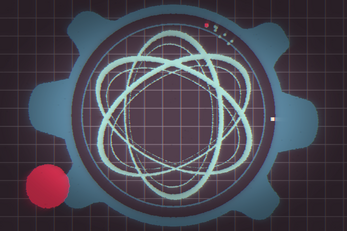
Late last year, I participated in the 9th GoedWare game jam and it took me 10 days to create this. Which is unusual, because all you do is go around in circle phasing through particles until the game becomes impossible to play. What you don’t see, is that for this game, I had to create a custom collision and particle system, stealing valuable time from development.
This is in contrast to now where, since I’m using Godot, I already have all of these systems and more in place, enabling me to focus more on creativity and less on technical setup.
Chances are you’re probably already using a game engine like Godot or Unity, but I encourage you to think about whether what you’re using or doing is actually slowing you down. In my early game development days when I was using Unreal Engine 4, I would start every single game jam by recreating my folder structure, implementing player movement, and getting the camera to work–all of this, I could’ve just turned into a template, saving me hours(!) per jam. Review your setup and ask yourself: “Am I reinventing the wheel each time?”
Strategize
It’s 4am, my alarm is blaring. I sit up groggy, then suddenly jolted with energy as the realization occurs that the game jam just started. I scramble onto my feet, turning off my alarm and on my computer, eagerly awaiting the theme for this jam and as I scroll down the page, it’s revealed: Isolation.
Immediately, an idea appears in my mind. A Dr. STONE-inspired survival game where everyone else has turned into stone and you have to uncover the secret formula that reverts these statues to their human state. The idea was a perfect match for the theme and I could already see the game being played in my mind.
But this isn’t my first rodeo.
With this wonderful idea in mind, many jammers would’ve opened up their game engine and started work. But I knew the futility of this approach, and instead, I opened up a document and started writing.
As I continued to explore the idea, I started asking questions and the cracks started to show.
- What’s the player going to be surviving from?
- What will the humans do once their revived?
- And, can I even code this in 10 days?
The idea that was going to dethrone Don’t Starve in the survival genre ending up being a bust.
I continued searching for more ideas and when I found one I was satisfied with, I did something my past self would’ve scoffed at.
I spent an entire day of a—keep in mind, 10-day game jam—planning.
I thought about the people who would be playing my game, what my goals were for this challenge, what my inspirations were, and at the end, I had a game design document that looked like this.
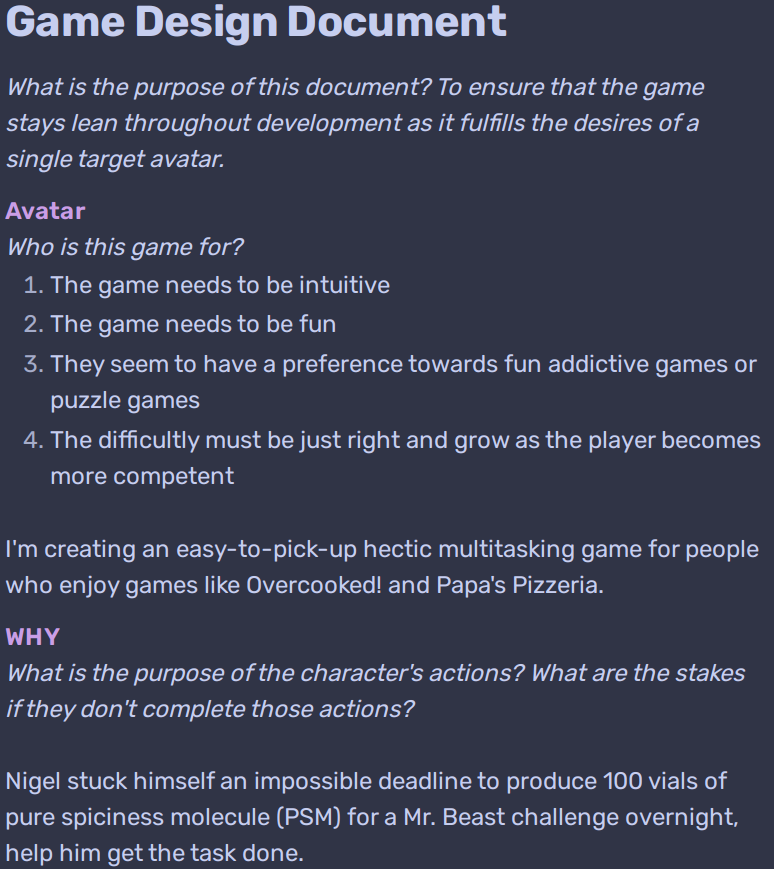
And I’m going to tell you right now, this was the greatest decision I made in the entirety of this jam, but when that day came to an end and I found that I didn’t even open my game engine yet, I couldn’t help but feel like I was doing something wrong.
I encourage you to take some time to plan out your game before you get started and to spend more time doing it than you think you need. To help you with that, here’s my game design document. In past game jams I participated in, I’d often find myself restarting my entire project because I never had a plan to begin with.
Execution
Black Swans
Three days into the game jam, I was done with final exams and had to move back home from university. This transition wasn’t smooth—as the entirety of the next day was spent running errands at Walmart, then in the kitchen preparing meals for the coming days. Six days in, a thunderstorm knocked out power in my neighborhood for the entire afternoon.

These disruptions are not uncommon during game jams, yet they’re some of the cited reasons for unfinished projects. I was determined not to let that happen to me. From past experience, I knew that thinking I had 10 days to work in a 10-day game jam was a fool’s errand, so, I took a few actions to sidestep this problem.
Reduce Frustration, Not Difficulty
There’s a thing you must know about the people who are rating your games, something I wish I knew when I started out. I was playing a platformer entry, and when I missed that very last jump when I thought I shouldn’t have and was sent all the way to the beginning of the level, I was brimming with frustration and ended my play session right there. I asked the other Discord members how they went through rating game jam entries, and their answer was a lot like mine: trying to play the game till the end, but stopping if they get stuck. As I was developing my own game, I constantly asked if what I was implementing made the game easier—not to play, but—to understand.
I had my friend playtest my game and even though the story at the beginning explained how to play, she missed the upgrade menu at the top-left, a critical component in progressing in this game. To remedy this, I added multiple quality of life features, on top of the ones I already had, to explicitly show the player how to play the game because I don’t want them getting frustrated. I even eased the difficulty by requiring 13 vials instead 15, knowing from experience what’s easy for the developer may be hard for some players and it’s always better to skew towards easy.
A Cure to Procrastination
Back in my Unreal Engine days as a beginner game developer, I would come back home from school around 3PM, complete my school work till 5PM, then work on my game until 9PM, of course while having a YouTube video playing in the background.
At this point, mental fatigue had set in and all my body wanted to do was relax for the upcoming day.
It wasn’t until university that I noticed something peculiar about the quality of my work. The work I did in the morning was significantly easier and of higher quality than the work I completed in the afternoon or night.
Many game developers optimize for the amount of hours they spend working on their game, working until their eyes are bleeding from staring at the screen. And I used to be one of them.
For this game jam, I found myself doing more higher quality work in less time, with less error, when I limited myself to just 5 or 6 hours of work in morning per day. In fact, on the days I tried to do more, I ended up working on lower priority tasks such as cleaning up the art rather than the bigger, needle-moving, tasks such as solidifying the game loop.
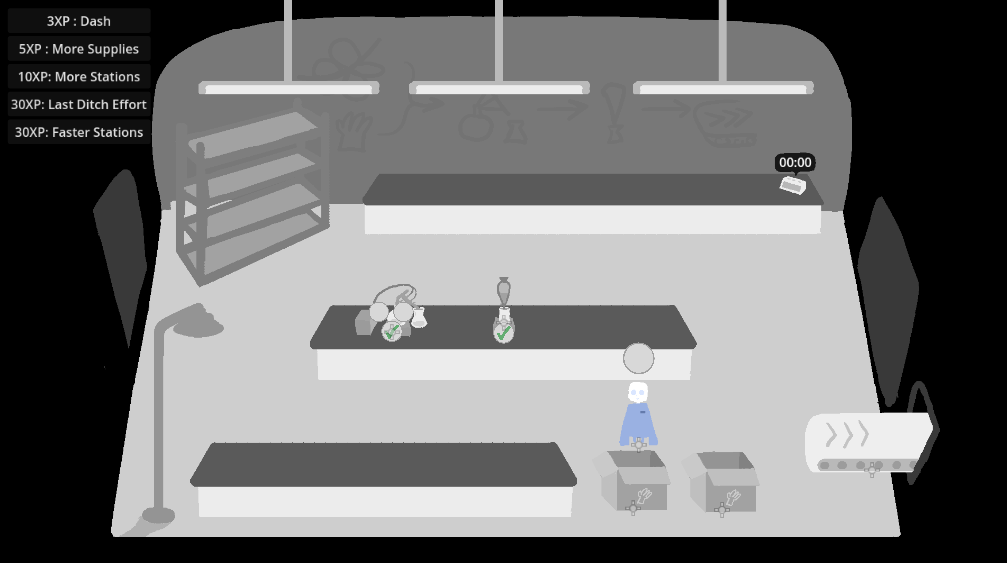
Magically, distractions (as long as I didn’t expose myself to them), stopped being a problem as I entered into the mystical state of flow, where every action flowed into the next like a series of dominoes expertly arranged to fall in perfect harmony. My creative energies surged like a river after a storm, and my TODO list was being cleared as if swept away by the current.
The Compounding Effect of Sticking to the Plan
I’m eight days into the game jam. My productivity is the best it has ever been, but there’s a calamity of a problem.
I haven’t played my game from start to finish—and I don’t know if it’s fun.
I was losing my mind.
I’m 80% through this challenge and doubt is brewing at the horizon. Did I tackle too much? Perhaps I should switch plans? Is there any way I can simplify this idea?
I was even went as far as confiding to ChatGPT my problem and this is what it had to say, “…You can turn this crunch into a powerful story for your YouTube channel—real-time problem solving, adapting on the fly, and pulling through under pressure are all gold for content. You’ve got this!”
I’m a sucker for these powerful turnaround stories, and wanted one for myself. I stuck to the plan and something amazing happening in those last 48 hours.
A sort of hockey stick curve of productivity occurred, allowing me to implement near all of the features I desired at the beginning of the game jam. In fact, by the end, my TODO list ended up looking like this, a feat I’ve never accomplished in past jams.
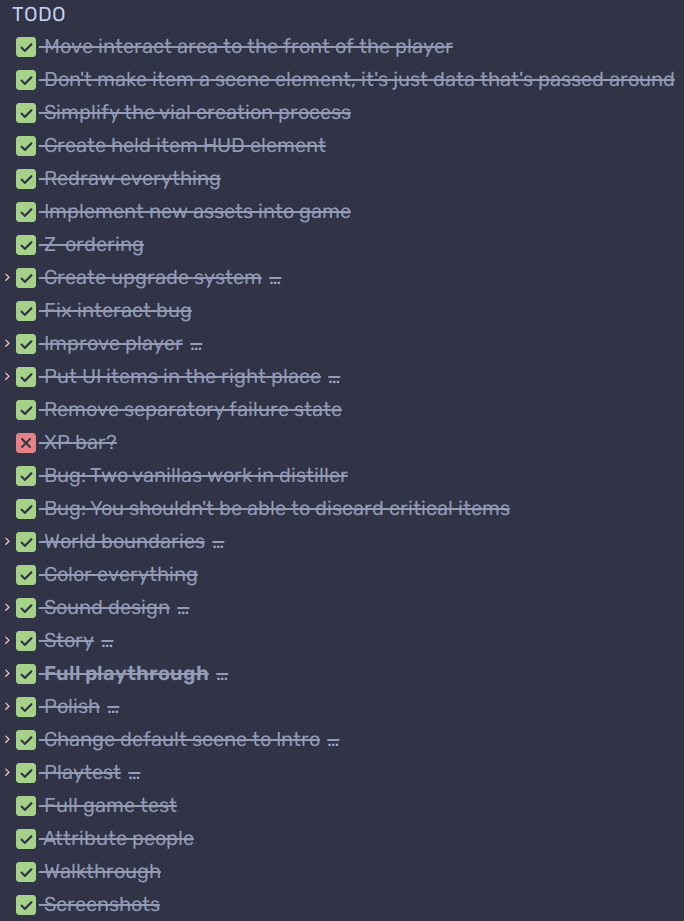
What I learned from this was the importance of sticking to the plan. The reason I never experienced any of this before was because I’d always switched ideas or restarted my project midway through the jam, essentially resetting this exponential curve of progress.
Reflection
One of the biggest mistakes I made throughout my game dev journey, and what caused my progress to stagnate during my high school years, was knowing how I could’ve improved my performance, but not taking any steps to improve.
Having submitted my entry, there are so many small optimizations I can implement that I know will lead to a 6+ hour speedup in development time for my next game jam. Crucial time I can use to improve the quality of the art and the game feel.
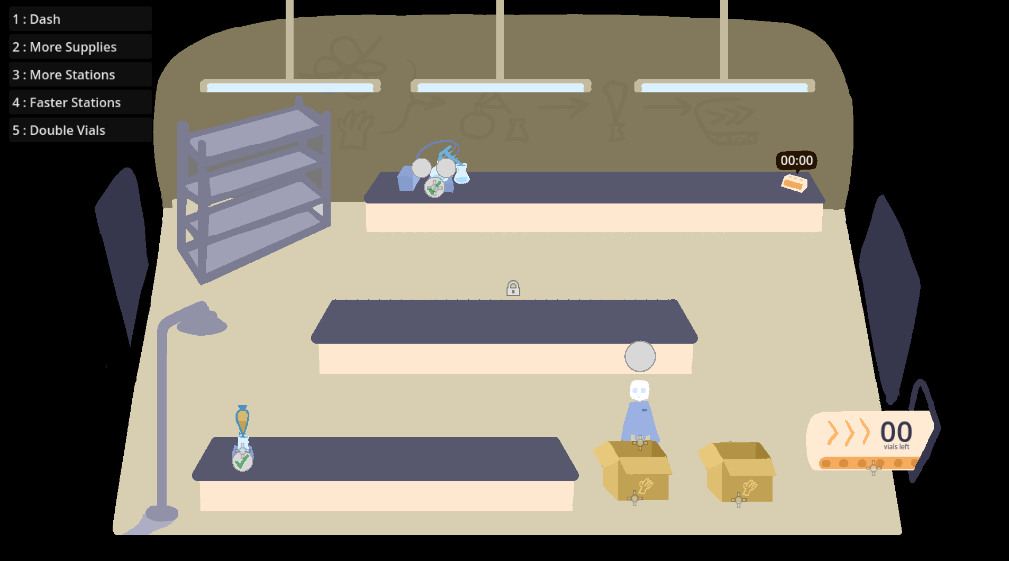
I was manually uploading my game files to itch.io, this process usually takes 5-10 minutes, which doesn’t sound like a lot, but ended up being a deterrent for me whenever I thought about doing playtests. Because of this, I only did one playtest session during the entire development of the game. But that’s not even the worst part, my web build was working during the playtest but failed 30 minutes before the deadline, an issue that, I later found the solution to within 10 minutes of searching for it.
This was issue I could’ve fixed in those 30 minutes if all I had to do was press a single button in order to create the builds and upload them to itch.
Optimizations:
- Knowing what tools are available to me and using them to amplify particularly my art skills
- Such as using Krita's batch export
- Using textured brushes/overlays for easy details
- I want to create a one-click system that will build my Godot game and upload them to itch
- Creating components I can drag-n-drop into my editor for easy handling of frequently used systems
The Ultimate Skill
All of this culminates into the ultimate skill that makes all of this work. This skill isn’t just about paying attention—it’s the art of selectively channeling your energy and resources to what truly matters before, during, and after the jam. In the chaotic environment of a game jam, where time is scarce and distractions are plentiful, mastering FOCUS can be the difference between a finished game and a forgotten project.
By maintaining a laser-sharp focus on the development priorities I set each day, I managed to implement all planned features, create all the art necessary, and implement quality of life features into my game all without sacrificing that initial idea that started it all.
The true potential of what can be accomplished in these compact time frames, be it during a 48-hour sprint or a 10-day marathon, is staggering. Game jams challenge us to push the boundaries of what we believe is possible in a limited period.
Embrace the discipline of Focus: let it Amplify your current abilities, Strategize your efforts efficiently, Execute your plans meticulously, and engage in meaningful Reflection on your results. Apply FASER in your next game jam, and watch as you not only reach but exceed your creative expectations.
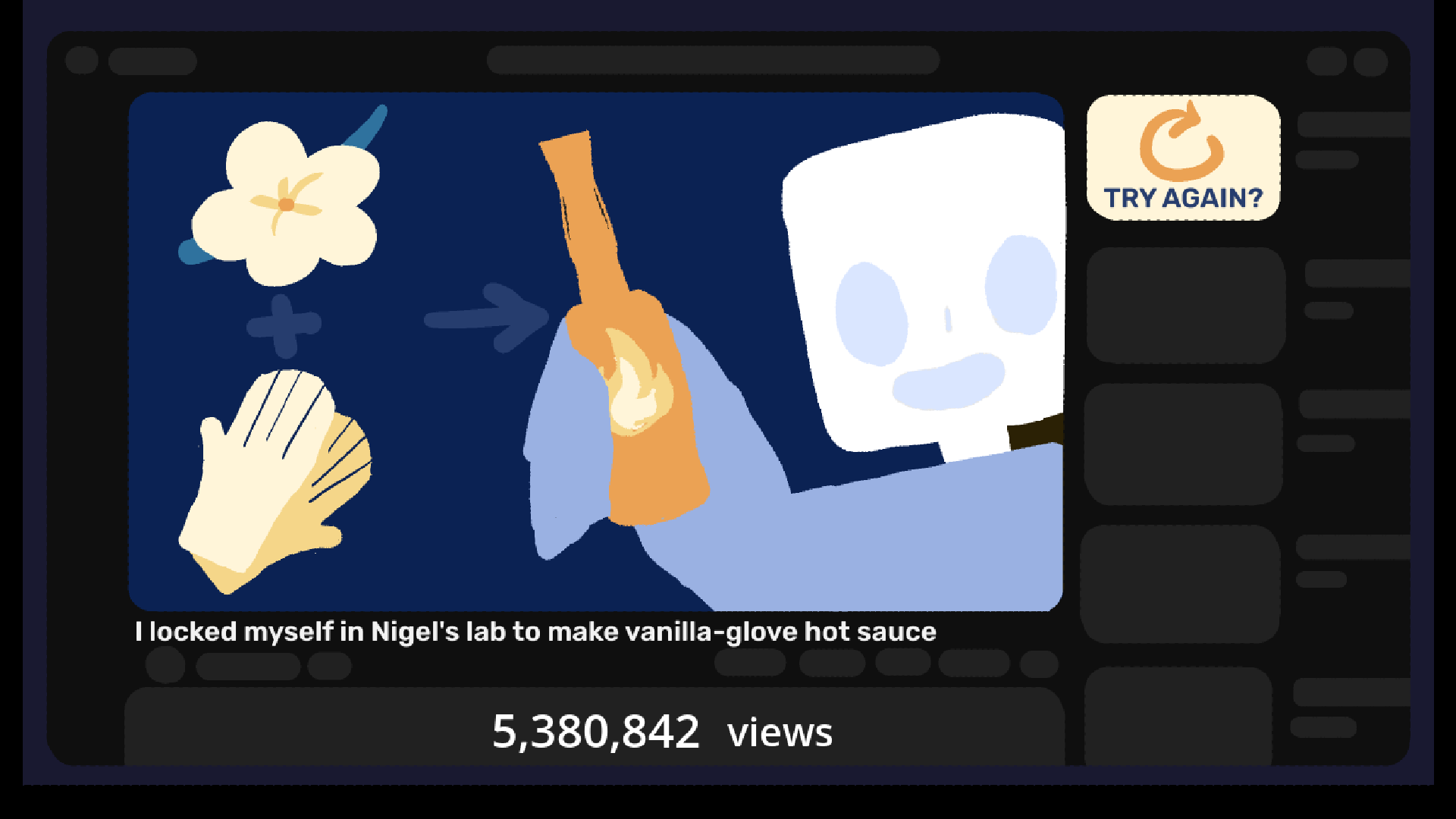
Files
Get Pure Spiciness Molecule
Pure Spiciness Molecule
Dash between stations, upgrade your lab, and create enough hot sauce in this overcooked-style game before time runs out!
| Status | Prototype |
| Author | Allen Dawodu |
| Genre | Simulation, Action |
| Tags | 2D, Casual, chemistry, Cute, Management, Singleplayer, Top-Down |
| Languages | English |
Leave a comment
Log in with itch.io to leave a comment.